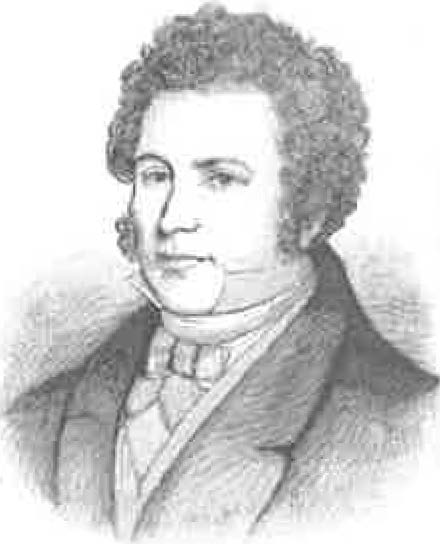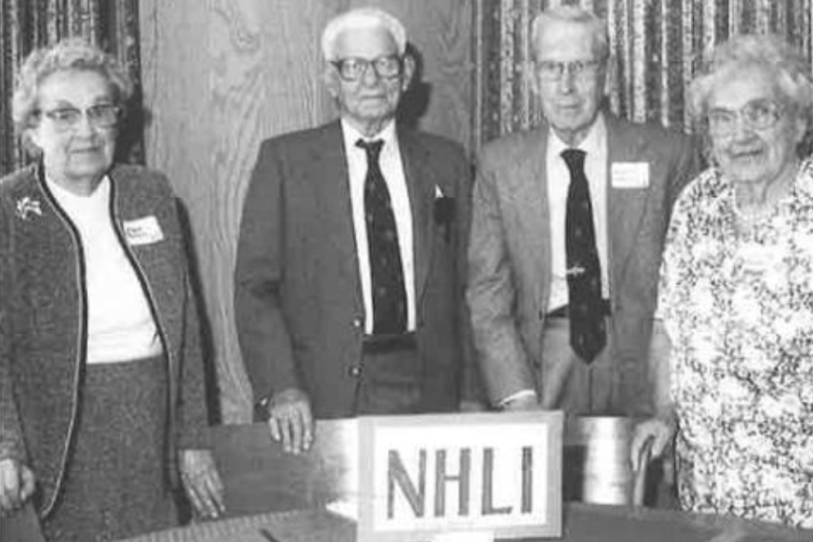The following article, “An Academy at New Hampton”, originally appeared in the Fall 1986 issue of Hamptonia as written by Norma Jean Moore for the 175th Anniversary of New Hampton School. Read the full article online. The article includes the above image captioned, “Distinguished alumni (l-r): Hope Swain ’25, Robert Hill ’21 ‘Mr. NHLI’, Everett Huckins ’28, Pauline Swain Merrill ’21.”
An Academy at New Hampton
In 1748 General Jonathan Moulton and his associates had been granted by the Masonian Proprietors a township, later to become Moultonborough, New Hampshire. Because of the outbreak of the French and Indian War in 1754, however, there was little new settlement in northern New Hampshire until 1763.
According to popular legend, in 1764, having explored his new territory and finding that much of it consisted of Red Hill, Lake Winnipesaukee, and the Ossipee Mountains, Moulton traveled to Portsmouth to the colonial governor, Benning Wentworth, and in exchange for the gift to the governor of a 1400-pound ox was granted an additional “small gore of land,” which today comprises the towns of Center Harbor and New Hampton. New Hampton was incorporated in 1777 and named for Hampton on the Atlantic seacoast, Moulton’s home town.
In midwinter 1775 Samuel Kelley of Exeter, having been granted the area which came to be known as Kelley’s Hill (the present Pinnacle Hill), made the trip to New Hampton overland with his family. Probably with a sled pulled by oxen carrying all their possessions, they crossed the ice of Kelley Pond (the present Pemigewasset Lake), climbed the hill and, it is believed, spent the first night camped out on a large boulder. The first settlers of New Hampton, Kelley and his family cleared the land under the Pinnacle and established a farm (the present home of T. Homes and Norma Jean Moore). They were followed the next year by Thomas Simpson, who was married to one of the Kelley daughters. The Simpsons settled down the road a quarter of a mile to the east (the present Jessie Ordway property).
Other settlers followed, clearing land and building homes in the Center (near the Town House), the Dana Hill area, the Fiske District (Old Bristol Road), the Oxbow area to the north of Dana Hill Road, and the Winona District. By 1805 six school districts, each with its own one-room elementary school, had been established; between 1807 and 1871 there were 17 districts.

New Hampton Academy 1821-1826
In 1789 Samuel Kelley built the present Town House as a church and a meeting house at the Center. Beginning in 1811 there was interest among the citizens of the Center, the wealthiest and most progressive section of the town, to establish an academy to provide secondary education for their children. In 1820 William Bowdoin Kelley, the first postmaster, John Kelley Simpson (who in 1805 had walked from his native New Hampton to Andover, Massachusetts, to enroll at Phillips Academy and had gone on to become a prosperous Boston merchant), and others took action to establish a secondary school at the Center. They built an “elegant building” on the common a few rods east of the Town House. In 1821 a group of the leading citizens of the Center procured a charter and became the proprietors of New Hampton Academy. William B. Kelley, Nathanial Norris, and Joshua Drake made up the first board of trustees.
The school was a success from the beginning in spite of the fact that the “new and elegant building…a two-story frame structure, twenty-four by thirty-two feet in size, had only one room ready for the opening of the first term. It was without libraries, apparatus, or even blackboards, furnished with plain unpainted seats and heated by a large open fireplace.” The site of the first schoolhouse is now marked by a large boulder bearing a bronze plaque, gift of the New Hampton School Class of 1921.
John Kelley Simpson of Boston persuaded 13 “Boys from this City” to make the difficult journey to central New Hampshire to attend the new academy and by correspondence was insistent that their regular reports be made to their parents. His patronage had a great deal to do with the success of the new school. When his own children became old enough, they moved to New Hampton with their mother so that they might attend.
For more information about the history of New Hampton School, read the full article.




